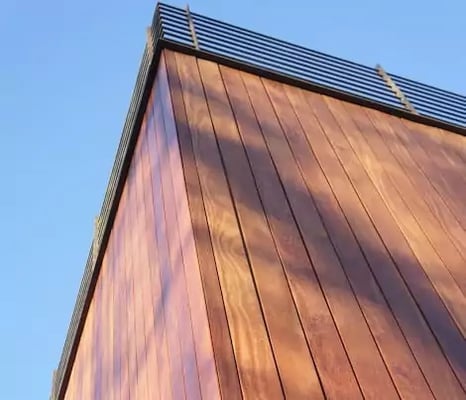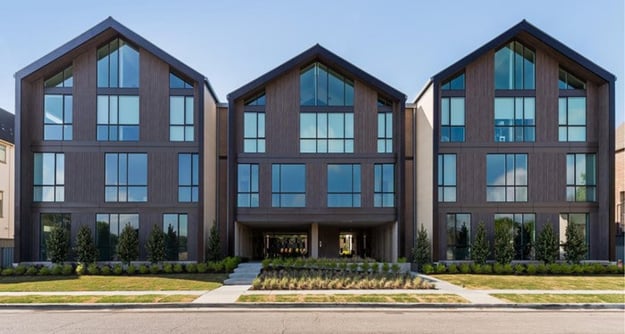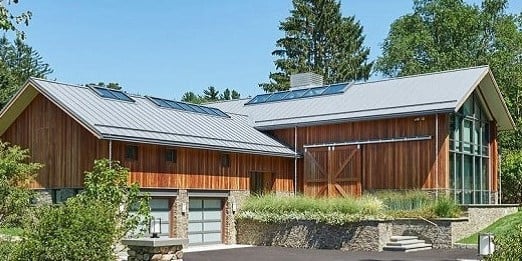
Vertical siding is a sought-after design trend. While board and batten style siding has long been a popular choice, it might not always be the best fit for your project. So, what if there were an alternative to the traditional board and batten approach? One that could offer a more contemporary appearance and simultaneously benefit your building's exterior. A proven vertical siding solution that can level up your exterior design?

Vertical wood rainscreen siding may be a better alternative for your project
What Is Board and Batten Siding?
Not your grandpa’s barn:
Board and batten was a method devised by early farmers to create structures such as barns, sheds, and cabins to keep water and weather out of the interior. The siding includes vertical “boards” laid out across the exterior of the building. A second layer of vertical planks, the “battens”, were added on top of the seams where the boards met, sealing the siding.
The layered dimensions gave these structures what we now think of as the iconic rustic or country look. Though its origins lie in the practicality of farm structures, the board and batten style has since evolved into a staple of modern exterior design.
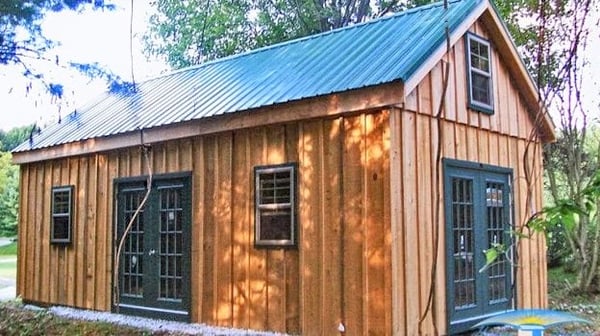
Get your copy of the Ultimate Guide to Building Green with Wood Rainscreen now:
The Board and Batten Trend
This timeless siding style has seen a resurgence in popularity in both residential and commercial design, thanks to its unique visual appeal and the ability to infuse a touch of charm into various architectural styles.
What people like about board and batten:
The allure of board and batten lies in its captivating aesthetics, vertically inclined pattern, textural richness, and the play of light and shadow the layering of siding planks creates on a building's facade.
It also does an excellent job of sealing out water and keeping it away from the building envelope. But it does not seal it out 100%.
What are the problems with board and batten:
When the board and batten trend started, it was primarily used for unheated, non-insulated, unconditioned spaces like barns and outbuildings. But when this look was eventually transferred over to heated, conditioned structures, it created a need for ventilation behind the siding. Various rainscreen methods have been used over time, including wood furring strips in closed-joint rainscreens.
The problem with using furring strips to attach your vertical siding is that the strips must run horizontally. Attaching furring strips horizontally behind a vertical rainscreen is an open invitation to water and trapped moisture hidden behind your closed joint rainscreen.
A closed joint system means the only place for the moisture and hot, humid air to escape is at the top of the wall. Bulk water drains at the bottom of the wall cavity. The horizontal furring strips can block the escape routes, holding that moisture against the wood. This leads to mold, rot, and decay over time.
Another method used for vertical rainscreen is a layered furring strip approach. It starts with rows of vertical furring strips against the building envelope. Then horizontal rows of furring strips are attached on to the vertical, creating a grid.
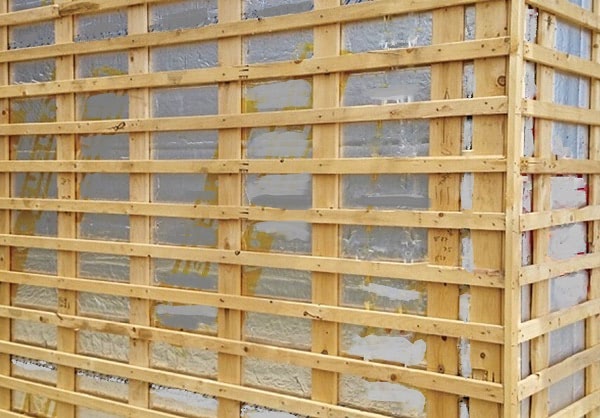
The problems with this method are fourfold:
- It takes extra installation time, materials, and labor.
- The layers of furring strips create a very deep rainscreen cavity (about 1-1/2”) behind the siding.
- That deeper cavity means you need to make returns for all your door and window openings. This results in even more installation time, labor, and materials.
- It also creates even more nooks and crannies for water to get trapped behind the siding.
How Is An Open Joint Rainscreen The Solution?
The concept of an open joint rainscreen siding system is also rooted in history. Specifically, Viking and other ancient populations. Many of these centuries-old buildings still stand today, due in great part to the design of the rainscreen.
 An ancient Norwegian stave church, an example of early rainscreen technology that you can still visit.
An ancient Norwegian stave church, an example of early rainscreen technology that you can still visit.
An open joint rainscreen lets water and fresh air run through the siding and back out. Humid air easily escapes from between the siding boards, not trapped against the building envelope.
Now, the open joint rainscreen has evolved for contemporary building exteriors. A well-designed rainscreen system on your exterior will reap big benefits and have a similar look to the board and batten style. Consider the Climate-Shield Rainscreen System, one that architects and builders have told us is the best designed on the market. Here’s what they like about it:
- Climate-Shield uses aluminum attachment rails that won’t rot or warp in moist environments.
- For vertical siding installations, Climate-Shield removes the need for furring strips at all, eliminating the grid of corners and pockets that could trap rainwater and humid air.
- Climate-Shield creates a highly functional rainscreen, without extra materials or labor.
- The patented components in the Climate-Shield system are engineered to be run vertically, diagonally, or horizontally. Design flexibility increased exponentially; no complicated workarounds needed.
- Plus, the rainscreen clips automatically create the correct rainscreen gap between your siding boards, while staying hidden from the eye.

But Can Rainscreen Create A Board and Batten Aesthetic?
Yes, It Can.
The benefits of the Climate-Shield System extend beyond its practical advantages. Its versatility allows for a broader spectrum of exterior design possibilities, ranging from classic and traditional to contemporary and modern aesthetics. Whether you opt for the charm of natural hardwood or the durability of premium wood-look siding, this system guarantees long-lasting curb appeal and enduring structural integrity.
If you like the look of the battens, there are several ways to achieve it using the Climate-Shield rainscreen system.
Wood Vertical Siding Ideas
If you like the look of the battens, there are several ways to achieve it using the Climate-Shield rainscreen system:

One method is to install battens intermittently between siding boards. At the University of Connecticut's recreation center, a board and batten look using vertical rainscreen. It was designed for a distinctly unique and contemporary look and was used on the exterior as well as the interior of the building.
Project: University of Connecticut Recreation Center
Materials: Ipe 1x6 hardwood vertical rainscreen with 2x6 vertical battens
Installation: Climate-Shield Rainscreen Siding

Emulate the rustic charm of a barn in a new construction home. Vertical siding mimics the board and batten of a barn and infuses your structure with timeless elegance. The practical side of rainscreen and Ipe wood siding is the weather-resistant durability and low maintenance.
Project: New construction of traditional barn-style guest house
Materials: Sustainable Ipe wood siding
Installation: Vertical Climate-Shield Rainscreen Siding
See more: Vertical Ipe Wood Rainscreen Adds To Traditional Barn Design
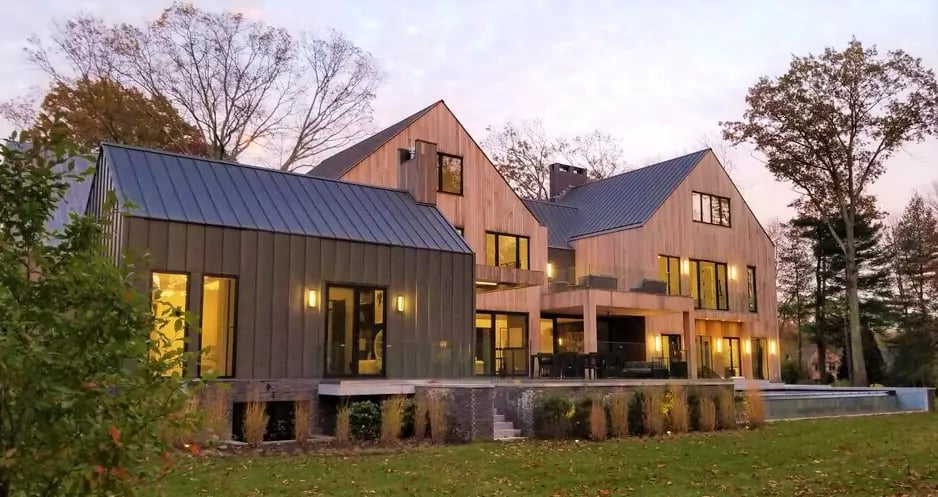
A contemporary board and batten feel with Garapa hardwood siding
Project: Residential
Materials: Sustainable Garapa wood siding
Installation: Vertical Climate-Shield Rainscreen Siding
See more: Vertical Ipe Wood Rainscreen Adds To Traditional Barn Design
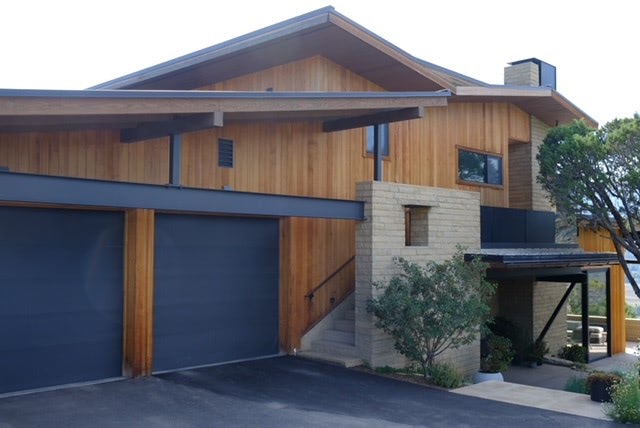
Thermally modified hemlock wraps a residential exterior. The colors of ThermaWood are darker than non-modified Hemlock, giving it a deeper color and grain pattern, which gives it a warmer visual impact.
Project: New construction of traditional barn-style guest house
Materials: ThermaWood Hem Fir, also available in ThermaWood FR with permanent fire retardant treated siding.
Installation: Vertical Climate-Shield Rainscreen Siding
See more: ThermaWood Siding Project Photo Gallery

A curved wall designed using two species of wood siding and vertical rainscreen installation helped achieve a beautiful, detailed facade that wraps around the students, welcoming them as they enter. Two types of FSC® certified hardwood gave a natural two-tone without adding additional finishing or maintenance.
Project: Custom designed elementary school
Materials: FSC Garapa and FSC Machiche hardwood siding
Installation: Vertical Climate-Shield Rainscreen Siding
See more: Climate-Shield Rainscreen System Chosen for the new Sandy Hook School
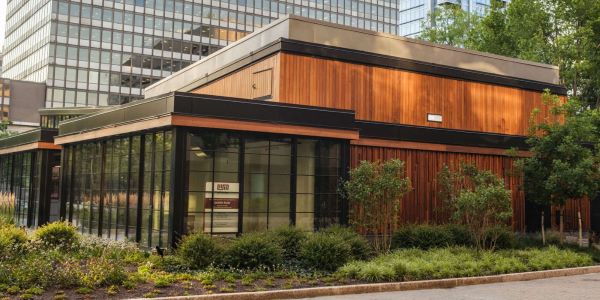
This project deserves two images so that you can see the innovative detail of the "batten" elements and the overall look. Leveraging its capacity to integrate 3D dimensional elements for a unique and engaging facade, a restaurant in D.C. designed a flowing textured exterior.
%20(2).jpg?width=600&height=350&name=Dining%20In%20The%20park%20Cumaru%20textured%20rainscreen%20exterior%20%20(600%20%C3%97%20350%20px)%20(2).jpg) Close-up of the modern architectural take on the traditional board and batten style
Close-up of the modern architectural take on the traditional board and batten style
Using layers of random lengths as "battens" over traditional vertical rainscreen installation, they were able to move the eye along the facade to create movement. A big draw for the design team was that Climate-Shield fasteners are hidden from onlookers, so they would not interrupt and break the visual pattern.
Project: Custom restaurant exterior
Materials: Sustainable Cumaru hardwood siding
Installation: Vertical Climate-Shield Rainscreen Siding
See more: Architectural Design Flexibility Evolves With Wood Rainscreen Siding
Wood-Look Vertical Siding Ideas
If you don’t want the maintenance of real wood, but you want the look, Pura NFC is a high-quality option to explore.
The integration of Pura NFC Siding by Trespa in their Wood Decors, with the Climate-Shield System components made especially for Trespa siding installation gives the ease of rainscreen with an incredible low maintenance, fade resistant wood-look siding option. This combination has been chosen repeatedly by Mataverde both commercial and residential customers who want a longer-lasting siding than composite or fiber cement can offer. Plus the added convenience of open joint rainscreen installation.
RELATED: Pura NFC Realistic Wood Decor Choices
Looking for an alternative to wood siding for your project? You owe it to yourself to check out the Pura NFC Siding Residential Project Portfolio.
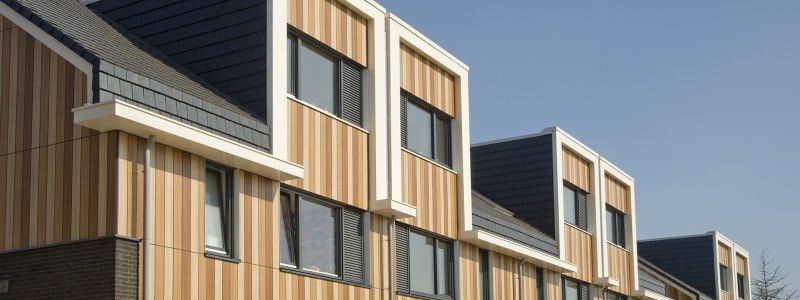
Using multiple shades of lighter Pura NFC Wood Decors, this housing complex gives "board and batten" with a contemporary twist. Pura decors can be mixed and matched for the exterior you want for your structure.
Project: Apartment complex
Materials: Pura NFC Wood Decors by Trespa
Installation: Vertical Climate-Shield Rainscreen Siding
See more: 9 Inspiring Designs Using Pura NFC Siding by Trespa
 Pura NFC Siberian Larch Wood Decor complements the stone exterior treatment and lets the red pop. Vertical installation using shorter-length boards adds a textural element.
Pura NFC Siberian Larch Wood Decor complements the stone exterior treatment and lets the red pop. Vertical installation using shorter-length boards adds a textural element.
Project: Fire station
Materials: Pura NFC Siberian larch Wood Decor
Installation: Vertical Climate-Shield Rainscreen Siding
See more: Pura NFC by Trespa Siding Commercial Project Photo Gallery
If you are an architect, builder, or property owner, find more ideas and information in the Pura NFC Siding Commercial Project Portfolio:
 Catch the black siding trend and avoid fading, staining, or refinishing with a dark Pura NFC Wood Decor like Slate Ebony on this residential addition. It gives a traditional feel with vertical rainscreen installation.
Catch the black siding trend and avoid fading, staining, or refinishing with a dark Pura NFC Wood Decor like Slate Ebony on this residential addition. It gives a traditional feel with vertical rainscreen installation.
Project: Residential Addition
Materials: Pura NFC Slate Ebony Wood Decor
Installation: Vertical Climate-Shield Rainscreen Siding
See more: Trending Black Siding Ideas and How To Recreate Them
Board and batten siding will always hold a nostalgic appeal, but the Climate-Shield Rainscreen System gives you a modern alternative that preserves the allure of vertical siding. With the added advantages of longevity, durability, easy installation, and design versatility. Climate-Shield Rainscreen can revolutionize the way you look at siding design and installation. Discover the potential of Climate-Shield for your next project and unlock a world of possibilities.

Related Posts
